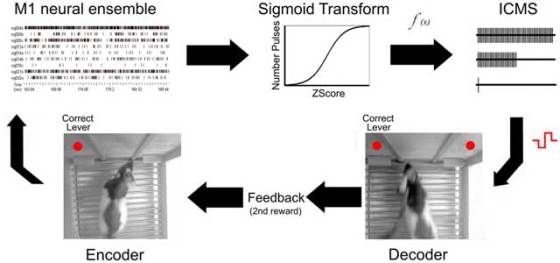Brain to brain interface transfers tactile and motor information
 Researchers at the Duke University managed to electronically link the brains of pairs of rats, thus enabling them to communicate directly in order to solve simple behavioral puzzles. Their new test of brain-to-brain interface is even more astounding because they succeeded to link the brains of two animals that were in different parts of the world – one in Durham, N.C., and one in Natal, Brazil.
Researchers at the Duke University managed to electronically link the brains of pairs of rats, thus enabling them to communicate directly in order to solve simple behavioral puzzles. Their new test of brain-to-brain interface is even more astounding because they succeeded to link the brains of two animals that were in different parts of the world – one in Durham, N.C., and one in Natal, Brazil.
“Our previous studies with brain-machine interfaces had convinced us that the rat brain was much more plastic than we had previously thought”, said Miguel Nicolelis, M.D., PhD, professor of neurobiology at Duke University School of Medicine and lead author of the publication. “In those experiments, the rat brain was able to adapt easily to accept input from devices outside the body and even learn how to process invisible infrared light generated by an artificial sensor. So, the question we asked was, ‘if the brain could assimilate signals from artificial sensors, could it also assimilate information input from sensors from a different body?’”
To test this hypothesis, researchers trained pairs of rats to solve a simple problem by giving them a reward after they pressed the correct lever when an indicator light above the lever is switched on. One of the two rodents was designated as the “encoder” animal. This animal received a visual cue that showed it which lever to press in exchange for a water reward. Once this “encoder” rat pressed the right lever, a sample of its brain activity which researchers interpreted as its behavioral decision was translated into a pattern of electrical stimulation.
They next connected the two animal’s brains via arrays of microelectrodes inserted into the area of the cortex that processes motor information. They used this connection to deliver the information directly into the brain of the second rodent, known as the “decoder” animal. The “decoder” rat had the same types of levers in its chamber, but it did not receive any visual cue indicating which lever it should press to obtain a reward. That means it had to rely on relayed information from its pair to get a reward.
The tests revealed that this brain-to-brain interface enabled a maximum success rate of about 70 percent, only slightly below the possible maximum success rate of 78 percent that the researchers had theorized was achievable based on success rates of sending signals directly to the decoder rat’s brain.
According to researches, the success rate of the pair communication provided by this brain-to-brain interface was increased because it was two-way. The encoder rat wouldn’t get the reward if the decoder rat didn’t press the correct lever.
“We saw that when the decoder rat committed an error, the encoder basically changed both its brain function and behavior to make it easier for its partner to get it right”, said Nicolelis. “The encoder improved the signal-to-noise ratio of its brain activity that represented the decision, so the signal became cleaner and easier to detect. And it made a quicker, cleaner decision to choose the correct lever to press. Invariably, when the encoder made those adaptations, the decoder got the right decision more often, so they both got a better reward.”
To test the transmission limits of the brain-to-brain communication, the researchers placed an encoder rat in Brazil, at the Edmond and Lily Safra International Institute of Neuroscience of Natal (ELS-IINN), and transmitted its brain signals over the Internet to a decoder rat in Durham, N.C. They found that the two rats could still work together despite the facts they were on different continents and the resulting noisy transmission and signal delays.
“In fact, our studies of the sensory cortex of the decoder rats in these experiments showed that the decoder’s brain began to represent in its tactile cortex not only its own whiskers, but the encoder rat’s whiskers, too”, said Nicolelis. “We detected cortical neurons that responded to both sets of whiskers, which means that the rat created a second representation of a second body on top of its own.”
Basic studies of such adaptations could lead to a new field that Nicolelis calls the “neurophysiology of social interaction”. The researchers claim that, in theory, the system could be used on a network of brains, or “brain-net.” Researchers at Duke and at the ELS-IINN are now working on experiments to link multiple animals cooperatively to solve more complex behavioral tasks.
Such complex experiments will be enabled by the laboratory’s ability to record brain signals from almost 2,000 brain cells at once. Duke researchers hope to record the electrical activity produced simultaneously by 10-30,000 cortical neurons in the next five years. Increased number of recorded brain cells could enable more precise control of motor neuroprostheses such as the one being developed by the Walk Again Project.
For more information, you can read the article published in the journal Scientific Reports: “A Brain-to-Brain Interface for Real-Time Sharing of Sensorimotor Information” [1.49MB PDF].










Leave your response!